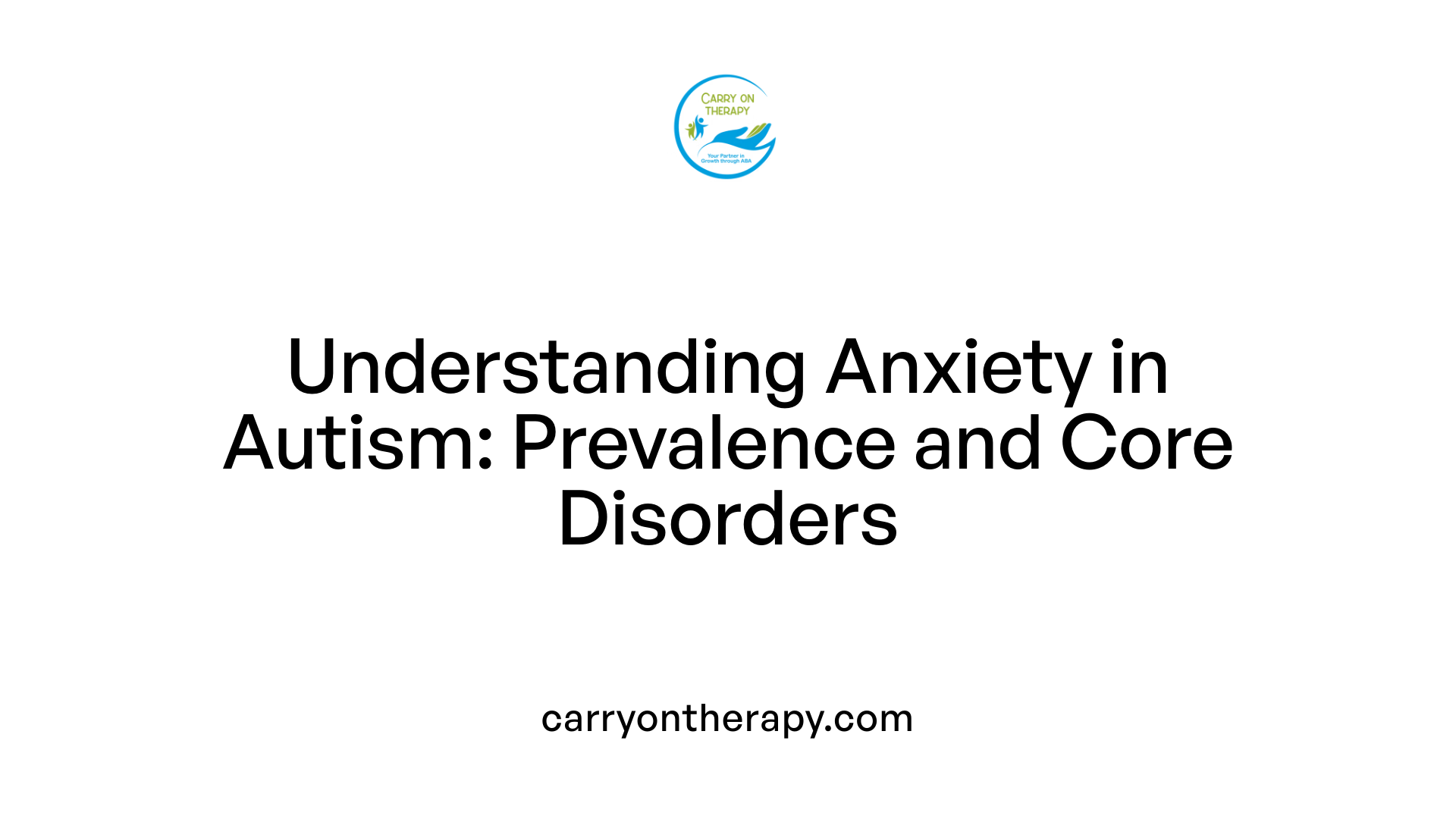Understanding the Link Between Autism and Anxiety
Anxiety disorders frequently accompany autism spectrum disorder (ASD), presenting unique challenges and complexities for affected individuals and their families. This article explores the connection between autism and anxiety, detailing how anxiety manifests within the autistic population, the implications for diagnosis and treatment, and the therapeutic strategies used to support these individuals. By understanding these dynamics, we can better address the needs of those facing this dual diagnosis.
Prevalence and Nature of Anxiety Disorders in Autism Spectrum Disorder

What is the prevalence of anxiety disorders among individuals with autism?
Anxiety disorders are highly prevalent in individuals with autism spectrum disorder (ASD). Studies show that approximately 40% of children and about 50% of adults with ASD experience some form of anxiety disorder. This high rate highlights anxiety as a common and significant comorbidity within the autism population.
What common anxiety disorders are seen in individuals with ASD?
Several specific anxiety disorders frequently co-occur with ASD. These include:
- Social Phobia: Occurs in roughly 17–30% of individuals with ASD, reflecting challenges in social interactions.
- Specific Phobias: Found in about 30–44% of cases, these involve intense fears of particular objects or situations.
- Generalized Anxiety Disorder: Present in 15–35%, characterized by pervasive worry across various domains.
- Separation Anxiety Disorder: Seen in 9–38%, involving excessive fear related to separation from attachment figures.
- Obsessive-Compulsive Disorder (OCD): Estimated prevalence ranges from 17–37%, featuring intrusive thoughts and repetitive behaviors.
What challenges exist in diagnosing anxiety due to symptom overlap?
Diagnosing anxiety in individuals with ASD is complex due to overlapping symptoms between anxiety and core autism features. For instance, social withdrawal and repetitive behaviors can be part of both anxiety and autism, making it difficult to distinguish one from the other. Communication difficulties in ASD can also limit the individual's ability to express anxious feelings clearly. Thus, comprehensive assessment methods, incorporating input from parents, teachers, and clinicians, are essential to accurately identify anxiety and guide effective treatment planning.
Complexities in Diagnosing Anxiety in Individuals with Autism

Why is diagnosing anxiety in individuals with ASD challenging?
Diagnosing anxiety in individuals with autism spectrum disorder (ASD) presents a unique set of challenges. One primary difficulty stems from the significant overlap between symptoms of anxiety and core autism characteristics. For example, social withdrawal and repetitive behaviors commonly seen in autism can also indicate anxiety, making it hard to distinguish between the two conditions.
Another obstacle in diagnosis arises from communication challenges inherent in ASD. Many individuals with autism may struggle to express their internal experiences or emotional states clearly, meaning their anxiety symptoms could go unrecognized or be misinterpreted.
Multimethod assessment approaches
Given these complexities, comprehensive and multimethod assessment approaches are recommended for accurately identifying anxiety in ASD. These typically incorporate a combination of parent reports, teacher observations, and clinician evaluations to gather a well-rounded perspective on the individual's behavior across different settings.
The use of specialized assessment tools tailored for autism and anxiety, though limited, can also support diagnostic accuracy. Instruments like the Screen for Child Anxiety Related Emotional Disorders (SCARED) have shown preliminary utility, but further validation is needed.
By employing varied sources of information and structured assessments, clinicians can better navigate the symptom overlap and communication hurdles, ultimately improving anxiety diagnosis and informing more effective treatment planning for individuals with ASD.
Risk Factors and Early Indicators of Anxiety in Autism

Role of restricted and repetitive behaviors (RRB)
Research has identified restricted and repetitive behaviors (RRB) as an important early risk factor for anxiety in autism spectrum disorder (ASD). Children with higher RRB scores around 4.6 years old are more likely to develop clinically significant anxiety by age 7.6 years. These behaviors, characterized by repetitive movements or routines, may contribute to anxiety by making it harder for individuals to adapt to new or uncertain situations.
Sensory processing difficulties
Sensory processing challenges also play a crucial role in the development of anxiety among individuals with ASD. However, interestingly, children with fewer sensory processing difficulties at age 4.6 were more prone to anxiety later on. Sensory sensitivities, such as heightened reactions to sounds or textures, can increase stress levels and anxiety, and early identification of these issues is essential for preventive support.
Influence of cognitive abilities and ASD severity
Cognitive functioning and ASD severity are key factors influencing anxiety risk. Higher IQ scores, especially in high-functioning ASD cases, are associated with an increased likelihood of anxiety disorders. Similarly, children with less severe autism features at baseline tend to experience higher levels of anxiety later, suggesting that greater awareness and social demands may elevate anxiety symptoms.
Familial and genetic contributions
Family history also contributes significantly to anxiety in ASD. Elevated parental anxiety, particularly maternal anxiety, is commonly observed in families where children have both ASD and anxiety disorders. This trend points to potential genetic and environmental influences, underlining the importance of incorporating family assessments in early screenings.
Early evaluation of RRB, sensory processing patterns, intellectual abilities, and familial anxiety can help clinicians identify children at greater risk. This comprehensive approach enables timely and targeted interventions tailored to prevent or reduce anxiety onset in autism spectrum disorder.
Cognitive Behavioral Therapy Adaptations for Autism and Anxiety

How effective is CBT in treating anxiety in individuals with ASD?
Research through systematic reviews and randomized clinical trials supports CBT as an effective intervention for anxiety in individuals with high-functioning autism spectrum disorder (ASD). When properly adapted, CBT significantly reduces anxiety symptoms, improving behaviors related to anxiety in youth and adults with ASD.
What modifications are made to CBT for use in ASD?
To address the unique challenges faced by those with ASD, CBT protocols are modified to include several key adaptations:
- Social Skills Training: Direct instruction in social skills helps individuals navigate interpersonal situations that often trigger anxiety.
- Family Involvement: Engaging family members supports the therapy process and reduces counterproductive accommodations, such as overprotectiveness.
- Visual Aids: Visual supports help clarify concepts and instructions, catering to different learning styles and communication needs.
- Individualized Reinforcers: Personalized rewards encourage participation and motivation throughout therapy.
How are visual aids and individualized reinforcers incorporated?
Visual aids such as schedules, charts, and storyboards make abstract CBT concepts concrete and accessible for individuals with ASD. They facilitate understanding of emotions and coping strategies. Individualized reinforcers—tailored rewards based on the child's interests—enhance engagement and reinforce desired behaviors during therapy sessions.
What role do systematic desensitization and graduated exposure have?
Behavioral approaches including systematic desensitization and graduated exposure are integral to CBT adaptations for anxiety in ASD. These methods gradually expose individuals to anxiety-provoking situations in a controlled way, allowing them to build tolerance and reduce avoidance behaviors. Reinforcement is often paired with exposure to increase effectiveness.
Together, these adaptations create a structured, supportive therapeutic environment that addresses both the core challenges of ASD and the manifestations of anxiety, leading to improved outcomes.
Behavioral Analysis and Autism Therapy: Foundations and Impact

What is applied behavior analysis therapy and how is it used to support individuals with autism?
Applied Behavior Analysis (ABA) therapy is a scientifically validated approach aimed at improving various skills and reducing challenging behaviors in individuals with autism. It operates on behavioral principles, emphasizing positive reinforcement to encourage desirable behaviors such as improved communication, social interaction, and adaptive skills. ABA therapy is highly individualized, tailoring intervention plans to each person’s unique needs and strengths.
Professionals trained in ABA design and implement systematic interventions, breaking down complex skills into smaller, manageable tasks. Techniques such as graduated exposure and reinforcement are commonly used, especially to assist with anxiety, which frequently co-occurs with autism. ABA also incorporates assessments of behavior functions, such as anxiety-related escape behaviors, to tailor strategies effectively. Family involvement and visual supports enhance the therapy’s effectiveness.
What outcomes or improvements can be expected from applied behavior analysis therapy for autism?
ABA therapy has been shown to produce significant improvements across several domains. Key outcomes include enhanced communication abilities, better social skills, increased adaptive behaviors, and a reduction in problematic or harmful behaviors. When initiated early and delivered intensively, ABA can substantially improve a person’s independence and social integration.
Results can vary depending on individual factors such as the severity of autism symptoms, intellectual functioning, and co-occurring conditions like anxiety. Modifications within ABA and related behavioral interventions, such as incorporating systematic desensitization for anxiety or teaching social skills directly, often increase success for individuals who are high functioning or facing additional challenges.
Consistent family involvement and the use of individualized reinforcement increase participation and long-term benefits. Overall, ABA remains a cornerstone intervention that supports many individuals with autism in achieving meaningful progress in everyday functioning.
Qualifications and Roles of Professionals Delivering Autism and Behavioral Therapies
What qualifications or certifications should professionals providing autism and behavioral analysis therapy have?
Professionals delivering autism and behavioral therapies typically obtain Board Certified Behavior Analyst (BCBA) certification. This credential requires a relevant master's degree in a field such as psychology, education, or behavior analysis.
In addition, candidates must complete a rigorous amount of supervised practical experience—usually between 1,500 and 2,000 hours—to develop hands-on skills before taking the BCBA certification exam. Many states further require licensure to practice and mandate continuing education to ensure updated knowledge and skills.
Role of Board Certified Behavior Analysts (BCBAs) and Registered Behavior Technicians (RBTs)
BCBAs are the professionals who design, oversee, and adjust behavioral intervention plans for individuals with autism. They use data-driven methods including applied behavior analysis to improve client outcomes.
Registered Behavior Technicians (RBTs) provide direct one-on-one therapy under the supervision of BCBAs. RBTs assist with implementing intervention plans, collecting data, and engaging clients in therapeutic activities.
Importance of supervised practical experience and continuing education
Supervised practical experience ensures that practitioners gain essential skills in assessment, individualized treatment planning, and behavior management under guidance from experienced clinicians.
Ongoing continuing education maintains professional competence, introducing advances in evidence-based techniques, ethics, and autism-specific treatment strategies. This commitment supports the delivery of the most effective, up-to-date care.
| Role | Educational Requirement | Experience Needed | Main Responsibilities |
|---|---|---|---|
| Board Certified Behavior Analyst (BCBA) | Master's degree + BACB coursework | 1,500–2,000 hours supervised fieldwork | Develops and supervises treatment plans |
| Registered Behavior Technician (RBT) | High school diploma + RBT training | Supervised by BCBA | Implements therapy, collects data |
This structured qualification pathway ensures that behavioral therapies for autism are delivered by well-trained, competent professionals equipped to address complex needs effectively.
Accessing Autism Therapy and Behavioral Analysis Services
How can families and caregivers access autism therapy and behavioral analysis services?
Families typically begin by consulting pediatricians or specialists, who can provide referrals to autism therapy and behavioral analysis services. Early evaluation is critical, as prompt diagnosis allows families to connect with appropriate supports and interventions tailored to the child's needs.
Referral pathways through pediatricians and specialists
Pediatricians and developmental specialists play a crucial role in early identification, guiding families toward specialized assessments and therapy programs. They often coordinate care plans and recommend evidence-based treatments such as Applied Behavior Analysis (ABA).
Early intervention programs for young children
Children from birth to age three can benefit from early intervention programs, which often provide free or low-cost services focusing on developmental delays related to autism. These programs emphasize behavioral therapies and family involvement to improve developmental outcomes.
Educational and Medicaid support programs
Starting at age three, children with autism become eligible for special education services under the Individuals with Disabilities Education Act (IDEA). Moreover, many Medicaid programs cover ABA services up to age twenty, offering families additional avenues for therapy access and financial assistance.
Importance of timely evaluation and intervention
Early and accurate evaluation helps ensure that therapeutic supports are individualized and integrated effectively. Given the high prevalence of anxiety and overlapping symptoms in autism, timely assessment allows for modifications in therapy—such as incorporating social skills training and visual aids—that improve treatment outcomes.
These coordinated pathways enhance the likelihood that children with autism receive comprehensive care addressing both core symptoms and common comorbidities such as anxiety.
Pharmacological and Complementary Treatments for Anxiety in Autism
Use of SSRIs and SNRIs in Anxiety Treatment for Typical Development
Selective serotonin reuptake inhibitors (SSRIs) and serotonin and norepinephrine reuptake inhibitors (SNRIs) are widely used and effective for treating anxiety disorders in typically developing youth. Their benefits include reducing symptoms such as excessive worry, panic, and social anxiety, providing pharmacological support when behavioral interventions alone are insufficient.
Limited Research on Pharmacological Treatments in ASD
Despite the proven efficacy of SSRIs and SNRIs in general anxiety treatment, research specific to individuals with autism spectrum disorder (ASD) remains limited. There is a pressing need for more studies to establish clear evidence-based guidelines for pharmacological management of anxiety within this population, considering unique neurodevelopmental factors.
Role of Atypical Antipsychotics for Related Symptoms
Atypical antipsychotics are not primarily prescribed for anxiety in ASD but are commonly used to manage irritability and aggression that can co-occur with anxiety symptoms. Their application highlights the complexity of symptom overlap in ASD and suggests that addressing these behavioral issues may indirectly improve anxiety-related challenges.
Complementary Approaches Such as Mindfulness and Accommodations
Beyond medication, complementary strategies such as mindfulness training have shown promise in reducing anxiety symptoms in autistic individuals. Additionally, environmental accommodations—modifying sensory inputs and reducing stressors—as well as professional psychological support, play crucial roles in comprehensive anxiety management for people with ASD.
| Treatment Type | Application in ASD Anxieties | Notes |
|---|---|---|
| SSRIs & SNRIs | Limited ASD-specific research | Effective in typical development-related anxiety |
| Atypical Antipsychotics | Manage irritability/aggression symptoms | Not primarily for anxiety but related behaviors |
| Mindfulness & Accommodations | Reduce anxiety, cope with sensory stresses | Complement behavioral and pharmacological treatments |
Family Dynamics and Support Strategies in Managing Anxiety with Autism
How does family accommodation impact anxiety treatment in ASD?
Family accommodation, such as overprotectiveness or modifying routines to reduce a child's anxiety, can inadvertently interfere with successful anxiety treatment in individuals with autism spectrum disorder (ASD). When families excessively accommodate avoidance behaviors, it may reinforce anxiety symptoms and limit opportunities for the individual to develop coping skills. Therefore, reducing such accommodation is essential to improve therapeutic outcomes.
What are effective strategies for reducing overprotectiveness?
Reducing overprotectiveness involves educating families about the importance of gradual exposure to anxiety-provoking situations combined with positive reinforcement. Therapists may work directly with parents to help them support their child's independent coping rather than shielding them from stressors. Encouraging consistent routines while fostering autonomy can balance support and promote anxiety management.
What role do social skills programs like the UCLA PEERS play?
Social skills training programs, such as UCLA PEERS, provide structured teaching of social interaction strategies which are often challenging for individuals with ASD. Participation in such programs has been shown to enhance social competence, reduce feelings of loneliness, and consequently decrease anxiety linked to social situations. These programs integrate principles from cognitive-behavioral therapy and are often incorporated alongside family involvement to improve effectiveness.
How can building coping skills and removing stressors aid in anxiety management?
Developing coping skills enables individuals with ASD to better handle anxiety triggers through techniques like mindfulness, self-regulation, and problem-solving. Removing or adapting environmental stressors—such as sensory overload or unpredictable social demands—helps reduce baseline anxiety levels. When combined with professional psychological interventions and family support, these strategies create a comprehensive approach tailored to the unique needs of each individual.
Bridging Understanding and Care for Autism and Anxiety
Recognizing and addressing anxiety within the autism community is vital to improving quality of life and developmental outcomes. While diagnosis can be complex due to overlapping symptoms, advances in behavioral therapies like adapted cognitive behavioral therapy and applied behavior analysis provide evidence-based pathways for relief and growth. Ensuring qualified professional support, early intervention access, family involvement, and tailored treatment plans are key components of effective care. Continued research and comprehensive approaches will enhance our ability to support individuals with autism and comorbid anxiety disorders toward greater independence and wellbeing.
References
- treatment of anxiety in individuals with autism spectrum ...
- Autism and Anxiety
- Comorbid autism spectrum disorder and anxiety disorders
- Early risk factors for anxiety disorders in children with ...
- Effects of cognitive-behavioral therapy on core aspects ...
- Applied Behavior Analysis (ABA)
- Applied Behavior Analysis (ABA)
- The Controversy Around ABA
You have to Start to be Great!






